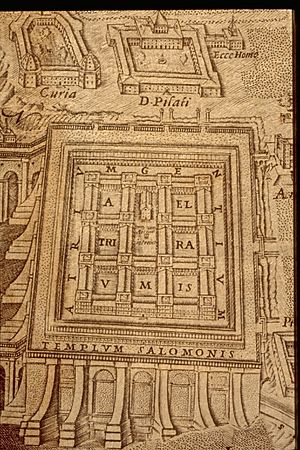Juan Bautista Villalpando facts for kids
Juan Bautista Villalpando (1552 – May 22, 1608) was a Spanish priest, a member of the Jesuits. He was also a smart scholar, a mathematician, and an architect. He is best known for his detailed drawings and ideas about what Solomon's Temple might have looked like.
Early Life and Studies
Villalpando was born in Córdoba, Spain, in 1552. He joined the Jesuit order in 1575. For the Jesuits, he helped design several buildings. These included the Cathedral in Baeza and the San Hermenegildo Church in Seville.
He studied geometry and architecture with Juan de Herrera. Herrera was a famous architect for Philip II of Spain, the king at that time. After becoming a priest, Villalpando focused on studying the Old Testament part of the Bible.
His Major Work

Villalpando's most important work as a scholar was a book about the prophet Ezekiel. He published it with Jerónimo del Prado in 1596. This book was supported by King Philip II.
His book, called Ezechielem Explanationes, included amazing drawings of Solomon's Temple. These drawings were very famous and had a big impact. He based them on the visions described by the prophet Ezekiel in the Bible.
Villalpando believed that the buildings in Jerusalem were designed using perfect geometry. His drawings showed them in a special way called orthographic projection. This is like looking at something straight on, without any perspective. He thought this was how God would see things.
He also had a new idea about classical orders in architecture. These are the styles of columns and buildings, like those from ancient Greece. Villalpando thought these styles actually came from God's instructions for Solomon's Temple. This was different from what other architects like Vitruvius believed.
Challenges and Influence
Because of his drawings and ideas, Villalpando faced questions from the Spanish Inquisition. They wanted to check if his ideas about the Bible were correct. But after looking at his beliefs and writings, they found him innocent.
In the same year, 1596, he traveled to Rome. He published more parts of his book there in 1604. He passed away in Rome on May 22, 1608.
Villalpando's pictures of Solomon's Temple were very influential. They inspired many artists and builders in Europe. His ideas helped shape the design of many monastery buildings during the baroque era. They also influenced how cities were planned. His images were even used in the design of Protestant churches and synagogues in the 1600s.
Villalpando was a student of Juan de Herrera. Herrera designed the famous El Escorial complex in Spain. Herrera's designs often included square courtyards and special projecting parts called risalits.
Some people had criticisms of Villalpando's work on the Temple. They said his designs for the temple's base were too big. They also felt his work didn't use enough real archaeological facts. Plus, he didn't use other important Jewish writings, like those from Josephus or Maimonides.
Villalpando also wrote books about gravity, geometry, and architecture. He especially focused on explaining the geometric rules behind buildings. Even famous scientist Isaac Newton used Villalpando's works in his own studies of architecture.
See also
 In Spanish: Juan Bautista Villalpando para niños
In Spanish: Juan Bautista Villalpando para niños


